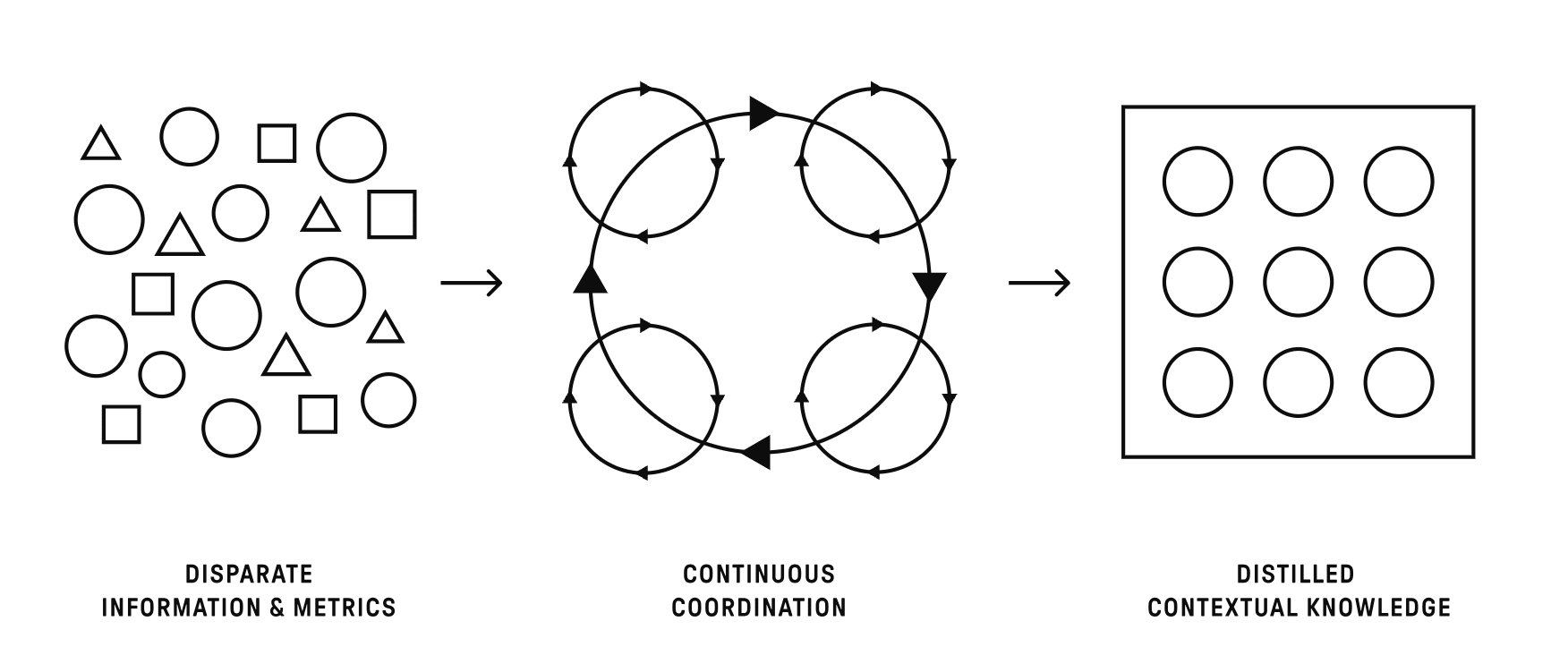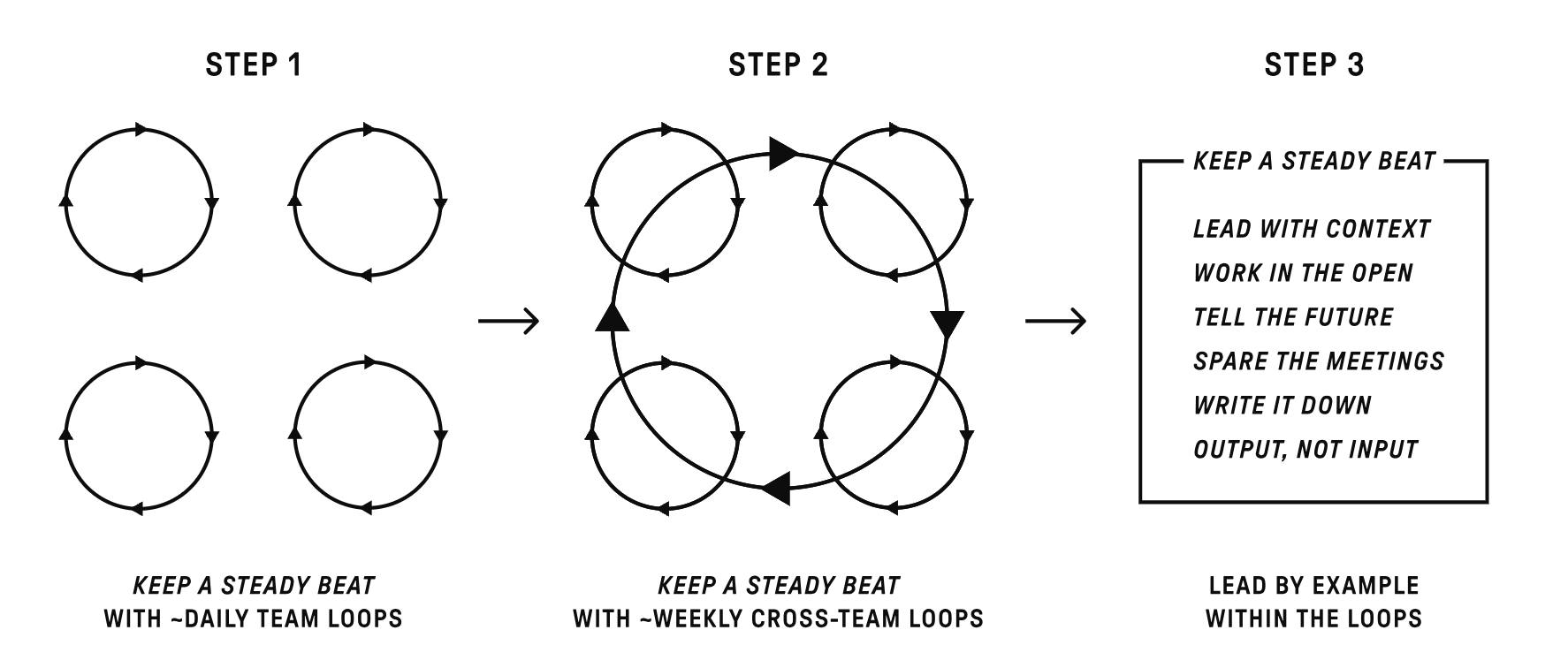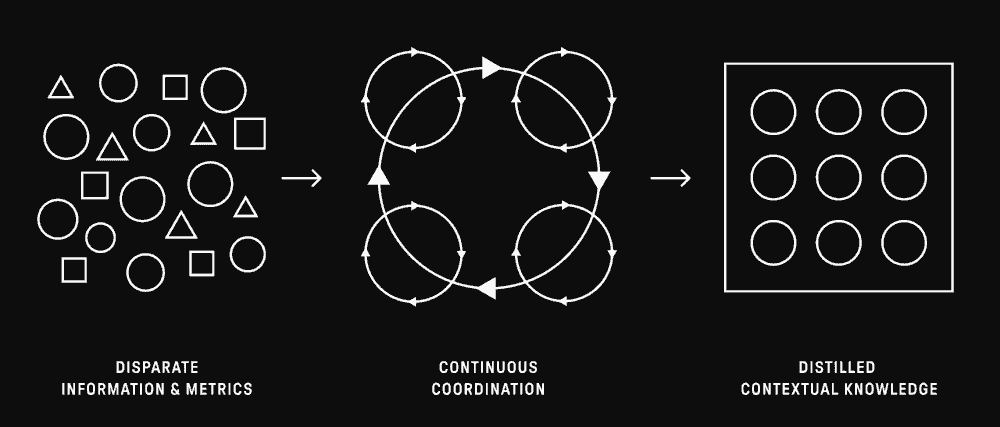February 15th, 2024
by Henry Poydar
in Leadership & Management, Team Communication, People & Culture
TL;DR
- Modern work is over-engineered and chaotic. We’re communicating with systems instead of each other, so productivity, quality, and engagement suffer. Continuous Coordination is a simple approach to fix that.
- Continuous Coordination is comprised of seven proven principles centered around establishing proactive communication loops within teams and companies.
- Continuous Coordination is an open-source framework developed by people with decades of experience in digital product and service organizations.
- Continuous Coordination layers on top of existing tools and processes and is easy to adopt. Implement it in three straightforward steps.
Modern knowledge work is broken
We’ve over-engineered “process tech” — project management, performance management, workflow automation, etc — and overlooked the fundamentals that drive real human collaboration. We’re communicating with our systems and tools instead of each other.
In doing so, we’ve lost the plot for progress, swamped in a dizzying constellation of bots, time zones, tasks, notifications, interruptions, mandates, emails, issues, chats, and back-to-back-to-back-to-back-to-back meetings. It’s a productivity-killing, morale-sapping burnout machine.
What’s worse is the exasperated tendency to accept this mess as the status quo. “That’s how it is here at XYZ Co, like everywhere. I get my real work done after hours.”
But it’s not like this everywhere. With decades of experience in remote, hybrid, and distributed work, my team and I have had the good fortune of witnessing and contributing within tech’s highest-performing organizations. Places where it’s invigorating to work. Where managers, contributors, and teams build things in harmony. Where Zoom fatigue is not a thing.
What do these standout orgs have in common? A people-first approach for collaborating and communicating that supersedes time, geography, and team boundaries. Continuous Coordination is the distillation of this approach.
At first, we set out to build Steady to enable the principles that make up Continuous Coordination. But along the way, we realized the principles themselves are the main character — a transformational set of ideas that floats all boats. Sure, Steady is a shortcut for implementing them, but they deserve elevation and treatment as a definitive approach to modern work on their own. And they should evolve as work evolves. So with the help of our colleagues, our customers, and industry thought leaders, we wrote it all down and published it under an open-source license.
The principles
Unlike factory work, knowledge work — thinking and constantly making decisions, large and small — is impossible without big picture context. From writing code to structuring a marketing campaign to prioritizing a roadmap, managers and contributors need a stream of information — who, what, where, when, how, and, most importantly, why — to work effectively.
Continuous Coordination is a set of seven principles for digital product and service organizations. The goal is constantly delivering the distilled context necessary to collaborate and get work done without requiring people to burn time and energy assembling it themselves. The results are substantial gains in productivity, work quality, and engagement.

Here is the what and why for each of the principles:
1. Keep a steady beat
- What: Use automated communication loops to routinely and proactively distribute work activity, plans, mission, and vision.
- Why: Ad-hoc approaches to keeping everyone informed and aligned are brittle, time-consuming, and tedious. Automated loops keep everyone in tight sync without all the effort and interruptions.
2. Lead with context
- What: Always give people the why for the work, not just the what and the when.
- Why: High-autonomy teams are high-functioning teams. Move the business forward by regularly giving people the context and coaching they need to make independent decisions.
3. Work in the open
- What: Share objectives and progress against them throughout your organization.
- Why: Transparency is the foundation of trust, the key ingredient for high-performing organizations. Plus, working in the open keeps stakeholders and adjacent teams up to speed without asks and interruptions.
4. Tell the future
- What: Include intent in all coordination communication.
- Why: You can learn from history, but you can change the future. When contributors communicate intent, leaders can course correct before days/weeks/months get burned. When leaders do it, contributors can drive progress autonomously.
5. Spare the meetings
- What: Save meetings for the high-value stuff — collaborating, team-building — and use asynchronous tools for the rest.
- Why: “Meeting hours” are the most precious commodity in a knowledge organization. They carry a high cost but are incredibly valuable when used correctly. Don’t squander them.
6. Write it down
- What: Default to writing for progress updates, strategy briefs, and the communication of intent.
- Why: Writing is the ultimate idea clarifier, refining ideas into their sharpest form before they get shared. It ensures that messages aren’t just heard, but understood. A culture of writing leads to stronger alignment for less effort, and fewer half-baked ideas.
7. Track output, not input
- What: Discard “performance” metrics that don’t correlate with desired outcomes.
- Why: When it comes to knowledge work, real productivity isn’t measured by hours clocked, meetings attended, or lines of code written. Focus on output and outcomes instead.
Getting started
Continuous Coordination is not designed to replace established tools, processes, or communication channels. Instead, it’s a lightweight overlay practice that offers instant improvements by solving for the underlying problems that typically hold organizations back: miscommunication, opaque vision, fractured context, micromanagement, and misalignment. You can try out the principles without the disruption you might face by completely changing processes, like switching from waterfall project management to an agile methodology.
Every digital product and service organization is different, which means there’s no precise formula for implementing Continuous Coordination, but there are three broad steps that work for most teams.

Step 1: Establish high-frequency, single-team communication loops
Implement Keep a steady beat at the team level on a daily basis by automatically gathering brief written check-ins from managers and contributors and distributing them to the team.
Step 2: Establish low-frequency communication loops for team and cross-team objectives
Implement Keep a steady beat at the organization level on a weekly, bi-weekly, or monthly basis by automatically gathering written goal updates and risk assessments and distributing them widely to the organization.
Step 3: Lead by example
Use the Keep a steady beat communication loops established in Steps 1 and 2 as vehicles to demonstrate the other 6 Continuous Coordination principles.
- Use check-ins and goal updates to Lead with context and constantly tie in overall mission and vision.
- Surfacing check-ins and goal updates to the whole organization is how to Work in the open.
- Cataloging plans and intentions within communication loops is the way to Tell the future.
- Written check-ins and updates reinforce the thinking that’s the basis for Write it down.
- Keeping a steady beat with written communication loops can avoid low-value “catch-up” and status meetings eschewed in Spare the meetings.
- Track output, not input by keeping updates focused on outcomes.
See the adoption guide on the Continuous Coordination website for further details.
Not coincidentally, the Steady platform is the most efficient and least intrusive way to follow these steps. Here’s how Steady automates the core principle of Continuous Coordination, Keep a steady beat.
Digging deeper
Explore these links and resources to learn more or get involved in the development of Continuous Coordination:
- Visit ContinuousCoordination.org
- Download the PDF
- Join the Continuous Coordination LinkedIn group
- Contribute on GitHub
- See how you can lever Steady to implement the principles

